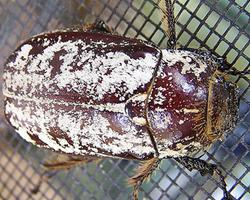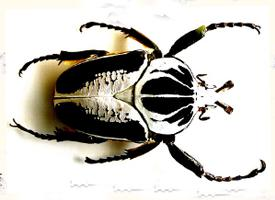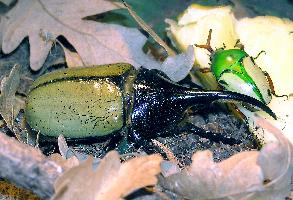
Poids et mesures
| Longueur | de 2,5 à 4 cm |
|---|
Description de l'animal
The European rhinoceros beetle, Oryctes nasicornis, is a captivating species of beetle that is a part of the Scarabaeidae family, which is well-known for encompassing some of the largest and most robust insects in the world. This species is indigenous to Europe and is particularly prevalent in the central and southern regions of the continent. Its range extends from the Iberian Peninsula in the west to the Balkans and parts of Asia Minor in the east, and from southern Scandinavia in the north to the Mediterranean areas in the south.One of the most distinguishing features of the European rhinoceros beetle is the prominent horn-like structure found on the males' heads, from which the beetle derives its name. This horn is actually an exaggerated form of the beetle's exoskeleton and is used primarily for fighting with other males over territory or potential mates. The females, in contrast, lack this pronounced horn and instead have a more modest, rounded head. Both sexes, however, possess a robust body that is covered in a hard exoskeleton that can vary in color from black to dark brown, sometimes with a slight greenish or bluish iridescence.
The adult European rhinoceros beetle typically measures between 25 to 40 millimeters in length, with males generally being larger than females. Their bodies are bulky and oval-shaped, with a pronounced convexity on their back. The elytra, or hardened forewings that cover the flight wings, are deeply ridged and contribute to the beetle's armored appearance. Despite their heavy build, these beetles are capable of flight, although they are not particularly adept fliers and usually only take to the air on warm evenings.
The larvae of the European rhinoceros beetle are C-shaped grubs that are creamy white in color with a brown head and can grow up to 80 millimeters in length. They develop in decomposing plant material, such as rotten wood or compost, where they play an important role in the process of decomposition and nutrient recycling. The larval stage can last for several years, depending on environmental conditions, before the larvae pupate and emerge as adults.
Adult European rhinoceros beetles are primarily nocturnal and are known to feed on tree sap, fruit, and plant matter. However, they are not considered pests and do not cause significant damage to living plants. Their presence is often indicated by the distinctive, deep buzzing sound they make during flight.
Conservation-wise, the European rhinoceros beetle is not currently considered to be at risk. It is a relatively common species within its range, although like many insects, it can be susceptible to habitat loss and changes in land use. The beetle's preference for decaying wood means that it can benefit from the preservation of old trees and the maintenance of natural wooded areas.
In summary, the European rhinoceros beetle is a remarkable insect with a unique appearance and interesting behaviors. Its role in the ecosystem as a decomposer is crucial, and its presence is a testament to the health of the environments it inhabits. With its striking horn and armored body, the European rhinoceros beetle is a fascinating subject of study for entomologists and a source of wonder for nature enthusiasts.
Animaux similaires
Nouvelles photos d'animaux
Top 10 des animaux
- Dolphin gull (Leucophaeus scoresbii)
- Japanese macaque (Macaca fuscata)
- Greek tortoise (Testudo graeca)
- Stone loach (Barbatula barbatula)
- Galápagos tortoise (Geochelone nigra complex)
- Russian tortoise (Testudo horsfieldii)
- Diana monkey (Cercopithecus diana)
- Moustached guenon (Cercopithecus cephus)
- Common flying dragon (Draco volans)
- Galápagos penguin (Spheniscus mendiculus)


